In the diverse landscapes of Illinois, ten species of finches add vibrancy to the avian tapestry. From the iconic American Goldfinch to the elusive Evening Grosbeak, these feathered residents play pivotal roles in the state’s ecosystems.
Each species brings a unique charm, contributing to the ecological balance through seed dispersal, insect control, and pollination.
As we delve into the fascinating world of finches in Illinois, we unveil their diverse habitats, behaviors, and ecological significance.
Join us in this exploration as we spotlight these ten remarkable finch species, shedding light on their roles in shaping the Prairie State’s rich biodiversity and environmental dynamics. Stay sharp.
10 Finches in Illinois
Find out about the diverse world of finches gracing the skies of Illinois. From the vibrant American Goldfinch to the elusive Two-barred Crossbill, each species brings its unique charm.
Join us in unraveling the fascinating lives of these feathered residents, understanding their habits, and appreciating their contribution to the rich avian tapestry of the region.
1. House Finch
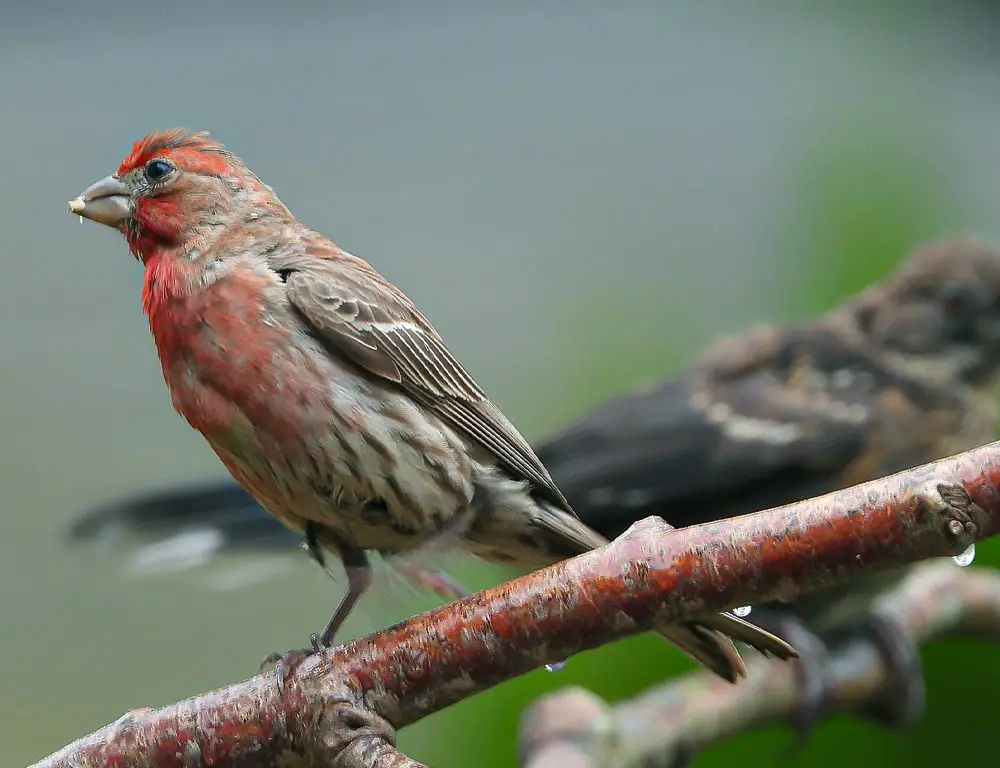
- Scientific name: Haemorhous mexicanus
- Population: Common and widespread
- Life span: 3 to 4 years
- Size: 5 to 6 inches
- Weight: 0.6 to 1 ounce
- Food: Seeds, fruits, and insects
- Wingspan: 8.2 to 10.2 inches
- Status: Stable
The House Finch, scientifically known as Haemorhous mexicanus, is a familiar sight in Illinois. With their brown-streaked plumage and distinctive song, these finches have adapted well to urban and suburban environments.
They are social birds, often found in flocks, and are known for their varied diet, feeding on seeds, fruits, and even insects.
House Finches are adaptable birds that use various habitats, including gardens, parks, and urban areas. They build cup-shaped nests in various locations, from trees to building ledges.
These finches exhibit a year-round breeding season, with the female being the primary nest builder. They have a relatively short life span of 3 to 4 years, during which they form strong social bonds within their flocks.
Their melodious songs and acrobatic flight patterns make them a delightful presence in the Illinois bird community.
2. Purple Finch
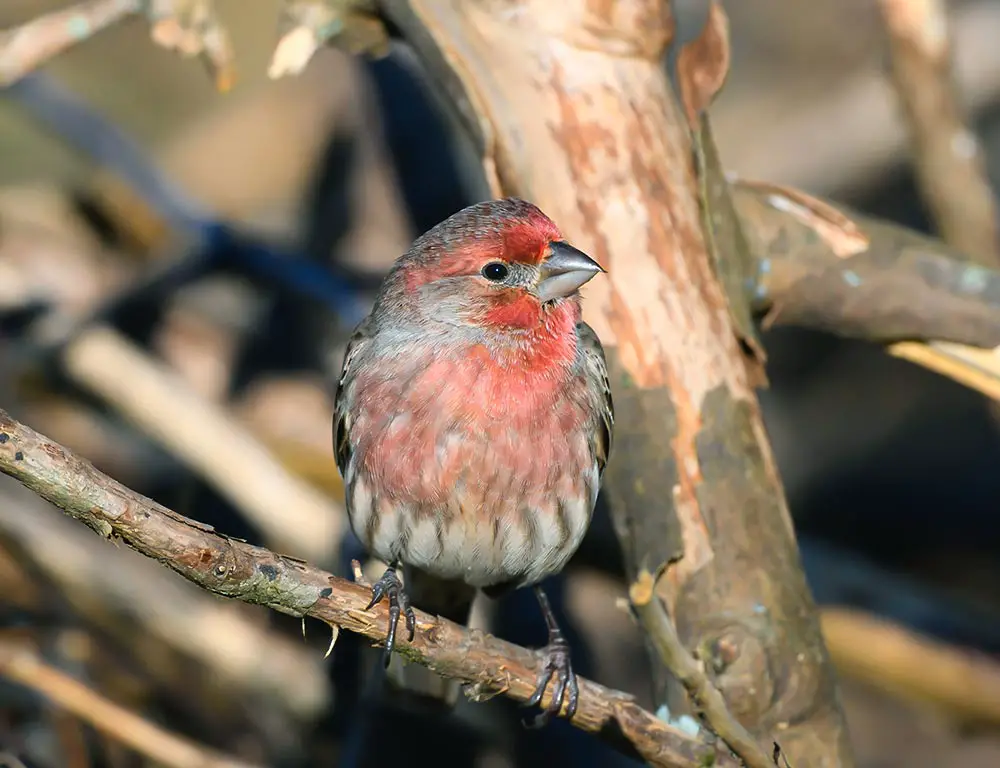
- Scientific name: Haemorhous purpureus
- Population: Common but declining
- Life span: 3 to 5 years
- Size: 6 to 7 inches
- Weight: 0.8 to 1.4 ounces
- Food: Seeds, fruits, and insects
- Wingspan: 9.1 to 10.6 inches
- Status: Declining
The Purple Finch, Haemorhous purpureus, is a colorful bird with a distinctive raspberry-hued plumage, especially in males.
Despite their name, the coloration can vary. They can be found in woodlands, gardens, and suburban areas in Illinois.
Purple Finches are known for their feeding habits, often perching on branches to crack open seeds.
They also consume fruits and insects, showcasing their adaptability. Unfortunately, their population in Illinois is declining due to various factors, including habitat loss.
They form monogamous pairs during the breeding season and build nests in trees or shrubs. With a life span of 3 to 5 years, these finches bring both beauty and ecological importance to the region.
3. American Goldfinch
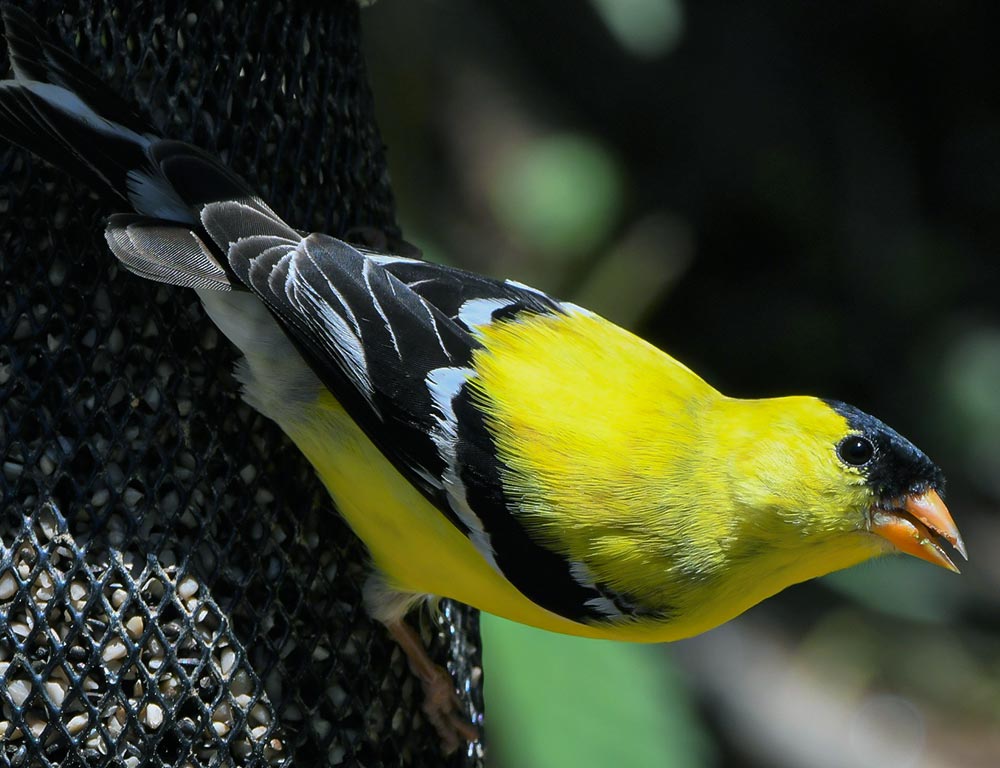
- Scientific name: Spinus tristis
- Population: Abundant
- Life span: 5 to 6 years
- Size: 4.3 to 5.5 inches
- Weight: 0.4 to 0.7 ounces
- Food: Seeds, especially from thistles and sunflowers
- Wingspan: 7.5 to 8.7 inches
- Status: Stable
The American Goldfinch, Spinus tristis, is a small, vibrant yellow bird with black wings and a distinctive song.
Found throughout Illinois, these finches undergo a remarkable change in plumage, transitioning from a bright yellow during the breeding season to a more subdued olive brown in winter.
American Goldfinches primarily feed on seeds, especially those from thistles and sunflowers. They are often seen hanging upside down to extract seeds from plants.
These finches have a relatively long life span of 5 to 6 years and are highly social, forming flocks during non-breeding seasons. Their ability to breed later in the summer, when seeds are abundant, sets them apart.
Their cheerful presence and aerial acrobatics make them a charming addition to the avian community in Illinois.
4. Red Crossbill
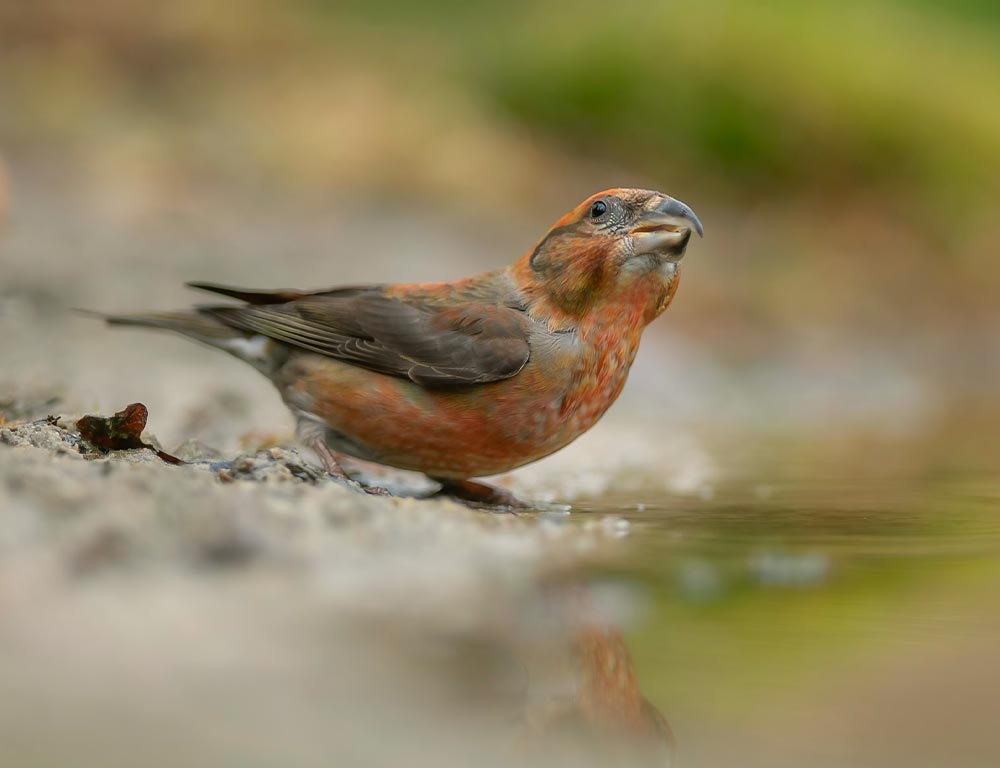
- Scientific name: Loxia curvirostra
- Population: Varies, can be locally abundant
- Life span: 3 to 7 years
- Size: 5.5 to 6.5 inches
- Weight: 1 to 1.5 ounces
- Food: Primarily feeds on conifer seeds
- Wingspan: 9 to 10 inches
- Status: Stable
The Red Crossbill, Loxia curvirostra, is a distinctive finch with a crossed bill adapted for extracting seeds from conifer cones.
Their plumage can vary in color from yellow-green to deep red. They are highly specialized feeders, relying on conifer seeds as a primary food source.
Red Crossbills are often found in coniferous forests, using their unique bills to pry open cone scales and extract seeds.
They exhibit a nomadic lifestyle, moving in search of cone crops. They may breed opportunistically, taking advantage of food availability.
Their population dynamics are influenced by the availability of conifer seeds, and their nomadic behavior makes them fascinating and challenging to study.
5. Common Redpoll

- Scientific name: Acanthis flammea
- Population: Variable, can be locally common
- Life span: 3 to 7 years
- Size: 5 to 6 inches
- Weight: 0.4 to 0.7 ounces
- Food: Primarily feeds on seeds, especially from birch and alder trees
- Wingspan: 9 to 10 inches
- Status: Stable
The Common Redpoll, Acanthis flammea, is a small finch with a streaked brown body, a distinctive red cap, and a black chin.
They are adapted for cold climates and are often found in northern regions, including Illinois, during winter migrations.
Common Redpolls feed on seeds, with a preference for those from birch and alder trees. During winter, they form flocks and may be seen at bird feeders.
Their breeding habits are influenced by food availability, and they build cup-shaped nests in trees or shrubs. Their adaptability to changing food sources and their charming appearance make them a welcomed winter visitor in Illinois.
6. Pine Siskin
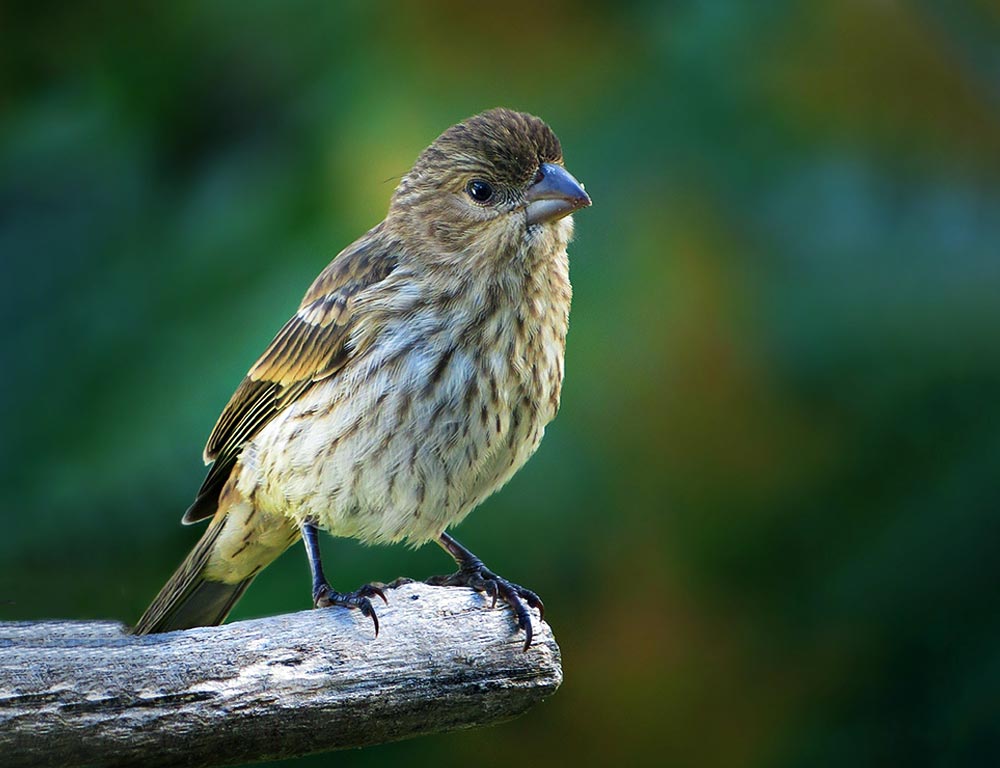
- Scientific name: Spinus pinus
- Population: Variable, can be irruptive
- Life span: 4 to 6 years
- Size: 4.5 to 5 inches
- Weight: 0.4 to 0.7 ounces
- Food: Primarily feeds on seeds, especially from conifers
- Wingspan: 8 to 9 inches
- Status: Stable
The Pine Siskin, Spinus pinus, is a small finch with a streaked brown body and subtle yellow wing markings. They are highly nomadic and can be found in various habitats, including coniferous forests, during winter.
Pine Siskins primarily feed on seeds, especially those from conifers. They are known for their disruptive behavior, where their population can fluctuate dramatically in response to food availability.
During irruptions, they may move southward, bringing them into Illinois during winter months. Their nomadic habits and disruptive behavior make them an interesting and dynamic part of the avian community.
7. Evening Grosbeak
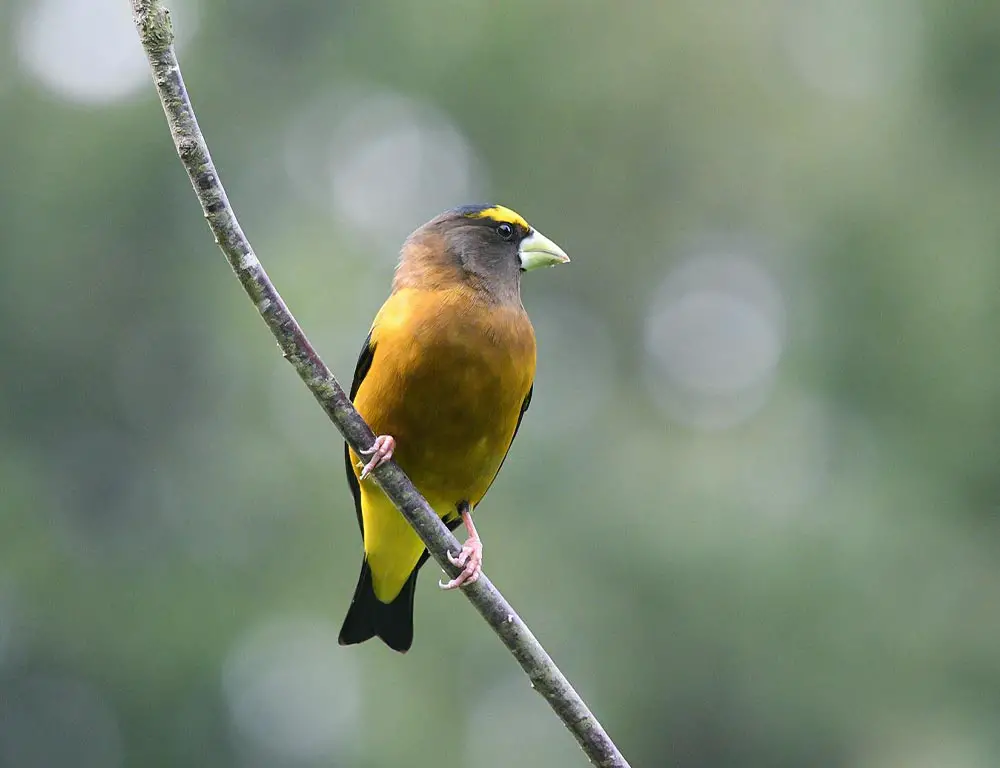
- Scientific name: Coccothraustes vespertinus
- Population: Declining in some regions
- Life span: 4 to 5 years
- Size: 6.5 to 8.5 inches
- Weight: 1.5 to 2 ounces
- Food: Feeds on seeds, fruits, and insects
- Wingspan: 12 to 15 inches
- Status: Declining
The Evening Grosbeak, Coccothraustes vespertinus, is a robust finch with a striking yellow body and a large, heavy beak.
Their populations have experienced declines in some areas, possibly due to habitat loss and changes in food availability.
Evening Grosbeaks are versatile feeders, consuming seeds, fruits, and insects. They are often seen in flocks, and their movements are influenced by the availability of their varied diet.
They build nests in coniferous trees and may breed in loose colonies. Their declining population highlights the importance of conservation efforts to protect their habitats and food sources.
Despite their challenges, the Evening Grosbeak remains a charismatic and visually stunning species in the birdlife of Illinois.
8. Two-barred Crossbill
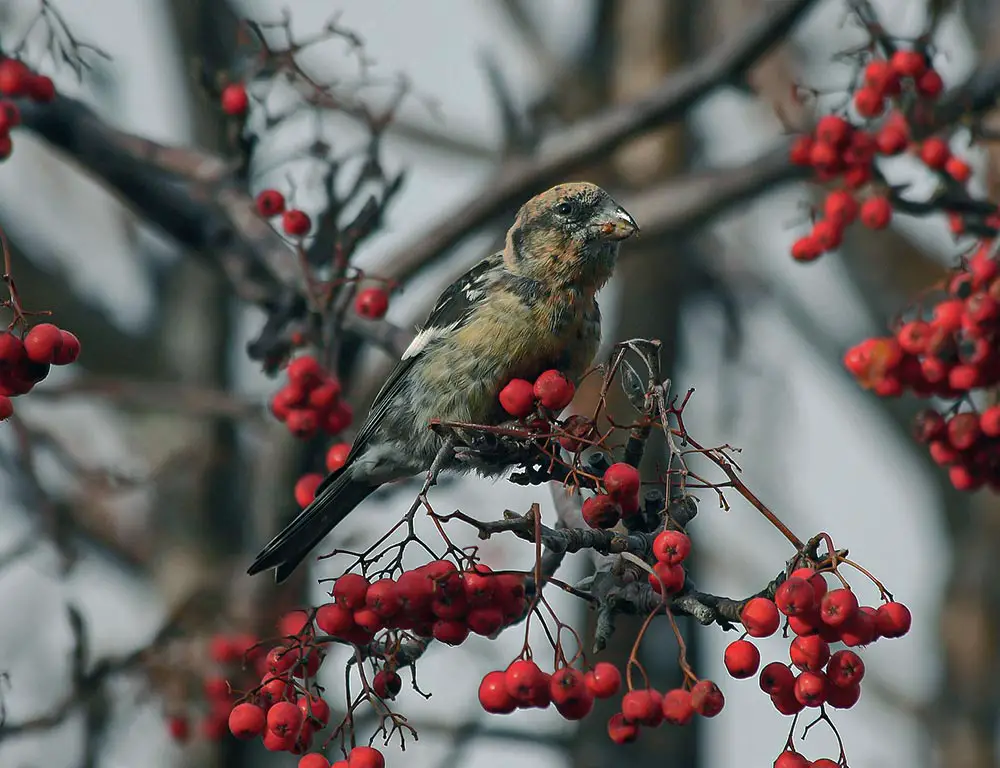
- Scientific name: Loxia leucoptera
- Population: Generally low, sporadic occurrences
- Life span: Information not well-documented
- Size: 6 to 7 inches
- Weight: Information not well-documented
- Food: Primarily feeds on conifer seeds
- Wingspan: Information not well-documented
- Status: Not well-documented, can be locally uncommon
The Two-barred Crossbill, Loxia leucoptera, is a crossbill species characterized by its crossed bill and distinct plumage.
It gets its name from the two white wing bars on its wings. This species is not as well-studied or documented as some other finches.
Little is known about the specific lifestyle of the Two-barred Crossbill in Illinois.
Crossbills, in general, are adapted for extracting seeds from conifer cones, and their movements are often influenced by the availability of these seeds.
Their presence in Illinois may be sporadic, and more research is needed to understand their habits and population dynamics in the region.
9. Arctic Redpoll
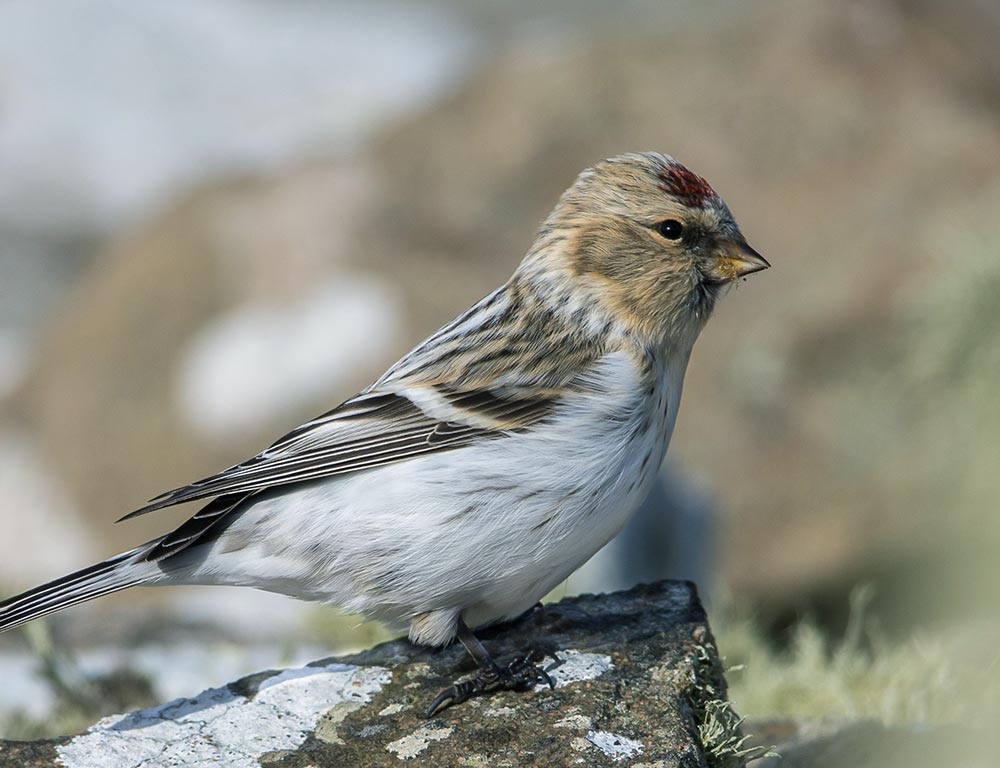
- Scientific name: Acanthis hornemanni
- Population: Variable, occasional in northern regions
- Life span: 3 to 7 years
- Size: 4.5 to 5 inches
- Weight: 0.5 to 0.8 ounces
- Food: Primarily feeds on seeds, especially from birch and alder trees
- Wingspan: 9 to 10 inches
- Status: Stable, occasional irruptions
The Arctic Redpoll, Acanthis hornemanni, is a smaller cousin of the Common Redpoll, with a similar appearance but often paler and with a smaller beak.
They are adapted to cold climates and can be found in northern regions, including parts of Illinois, during winter migrations.
Like Common Redpolls, Arctic Redpolls primarily feed on seeds, particularly those from birch and alder trees. They may form flocks and visit bird feeders during the winter.
Their irruptive behavior can lead them to move southward in search of food during certain years, bringing them to regions like Illinois. Studying their movements during these irruptions provides insights into their dynamic ecology.
10. Pine Grosbeak
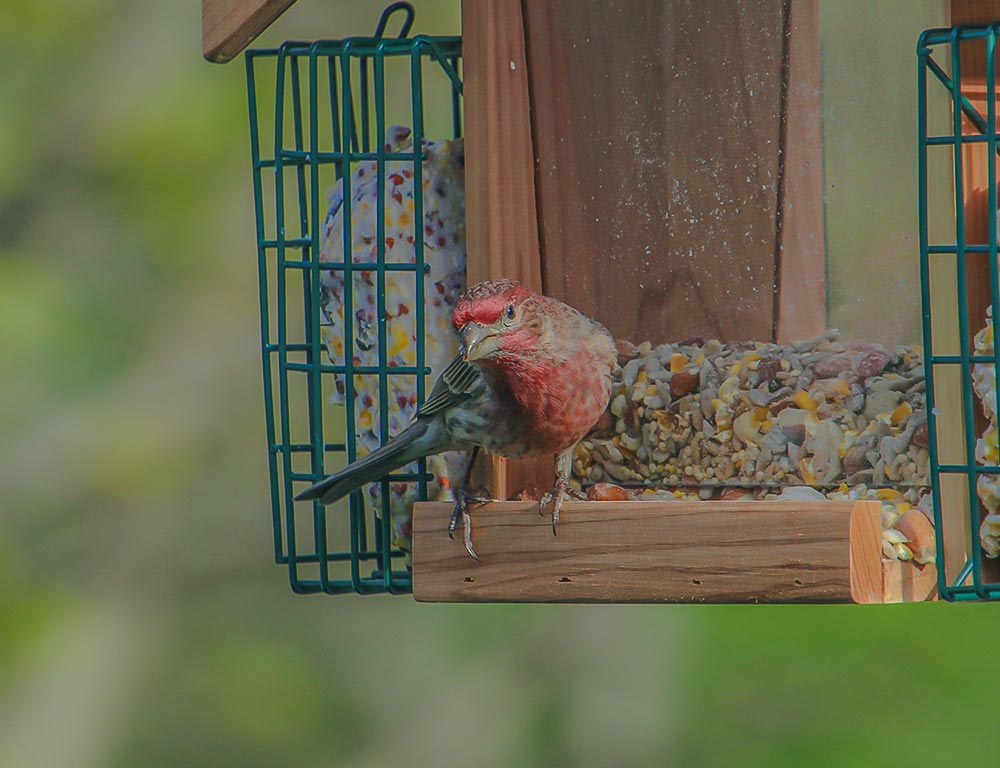
- Scientific name: Pinicola enucleator
- Population: Varies, occasionally in northern regions
- Life span: 5 to 7 years
- Size: 8 to 10 inches
- Weight: 2 to 3 ounces
- Food: Feeds on seeds, fruits, and buds
- Wingspan: 13 to 15 inches
- Status: Stable, occasional irruptions
The Pine Grosbeak, Pinicola enucleator, is a large and robust finch with a distinctive red plumage.
Males are particularly striking with their bright red coloration. They are adapted to northern habitats but are occasionally found in Illinois during winter.
Pine Grosbeaks feed on a varied diet, including seeds, fruits, and buds. They may visit bird feeders in search of food.
Like other irruptive species, their movements are influenced by food availability, and their presence in Illinois can vary yearly. They build nests in coniferous trees during the breeding season.
Despite their occasional appearances, Pine Grosbeaks contribute to the diverse avian community in northern regions, bringing a splash of color during winter months.
Ecological Significance of Finches in Illinois
Finches play a pivotal role in the mosaic of Illinois’ ecosystems, contributing to the state’s ecological balance and biodiversity. Their varied species, each with distinctive traits, weave intricate connections within the natural tapestry.
Let’s delve into the ecological significance of finches in Illinois and unravel the threads that link these avian residents to the health and vitality of their habitats.
Seed Dispersal
Finches, particularly those specializing in seed consumption like the American Goldfinch, serve as crucial seed dispersal agents.
Their foraging activities contribute to the regeneration of plant species, fostering biodiversity and maintaining ecosystem health.
Insect Control
The foraging habits of finches, including the House Finch, extend beyond seeds to include insects.
Finches act as natural pest controllers by consuming pests that might otherwise harm crops and vegetation, promoting a balanced and resilient environment.
Pollination Partners
Some finches, such as the Evening Grosbeak, contribute to pollination by feeding on nectar and inadvertently transferring pollen between flowers.
This interaction aids in reproducing flowering plants, supporting the overall structure of Illinois’ ecosystems.
Indicator Species
Changes in finch populations can serve as indicators of broader ecological shifts.
Monitoring these avian communities provides valuable insights into the health of ecosystems, offering early warnings of environmental changes or disturbances that may impact various species.
Diversity in Habitats
The adaptability of finches, ranging from the nomadic Pine Siskin to the coniferous forest-dwelling Two-barred Crossbill, showcases their ability to inhabit diverse ecosystems.
Their presence in different habitats contributes to Illinois’s overall biodiversity and ecological resilience.
Educational Value
Studying finches in Illinois provides educational opportunities for researchers, conservationists, and the general public.
By understanding their behaviors, migratory patterns, and interactions with the environment, we gain knowledge essential for effective conservation and the sustainable management of natural resources.
Wrapping Up
In the intricate web of Illinois’ ecosystems, finches emerge as ecological keystones, weaving threads of seed dispersal, insect control, and pollination.
Their adaptability and diverse habitats make them indicators of environmental health, while their study provides insights crucial for conservation.
As stewards of biodiversity, understanding and appreciating the role of finches fosters a deeper connection with the natural world, emphasizing the delicate balance sustaining Illinois’ varied landscapes.
Through our exploration of these avian residents, we unveil the significance of finches in shaping the resilience and vitality of the state’s ecosystems. Thank you so much.